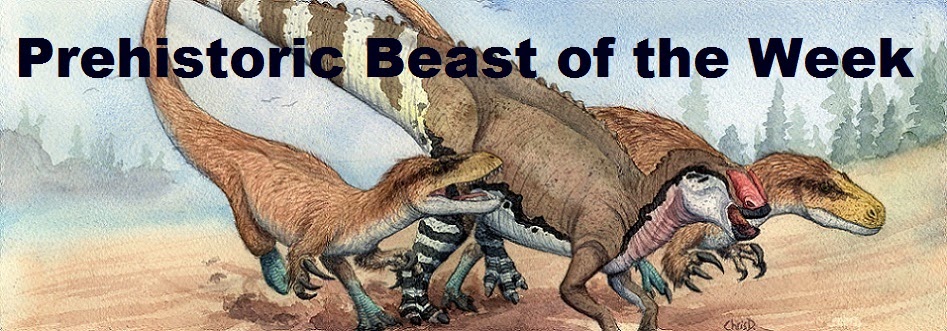This week we'll be looking at a newly described little dinosaur that greatly expands our knowledge on one of the most unusual kinds of dinosaurs, the pachycephalosaurs. Welcome Zavacephale rinpoche!
Zavacephale lived in what is now Mongolia during the early Cretaceous period, between 119 and 110 million years ago. From snout to tail the specimen found would have only been about three feet (1 meter) in length, but it likely would have been able to grow larger. The genus name, Zavacephale, translates to "Origin/Root Head" in reference to the fact that it is the oldest pachycephalosaur found to date. The species name, rinpoche, is Tibetan for "precious one" because when it's skull was first discovered, it reminded the scientists who named it of a precious gem the way it was partially exposed from a sandy outcrop in the Gobi Desert.
Zavacephale was an early member of the pachycephalosaur family of dinosaurs. Most famous for the latest and largest member, Pachycephalosaurus, itself, they are most well known for having thick, dome-shaped skulls surrounded by small horns. They are historically associated with being plant-eaters, but more recently its been suggested they were more omnivorous judging by some of their teeth. Zavacephale is extremely important because up until it's discovery, every pachycephalosaur known has been from the end of the Cretaceous, but Zavacephale lived millions of years prior in the early Cretaceous, making it the oldest member of this group by a long shot. What makes this more interesting is the fact that despite this, Zavacephale still has a very pronounced thickened dome skull, like its later relatives, meaning this famous feature of the group evolved even earlier than Zavacephale's time, possibly back in the Jurassic period?
 |
| Photograph of Zavacephale's skull. Note the sharp teeth in the front of the mouth. |
The individual Zavacephale that was discovered was only a juvenile that wasn't done growing when it died. Paleontologists know this because most of its bones weren't completely fused together, which is the case with more mature dinosaurs. The one part that was fully formed, however, was its domed skull. This is interesting since pachycephalosuars are typically thought to have used these specialized skulls for fighting within the species for dominance, which is associated with being a mature adult. The fact that Zavacephale's dome was fully formed while the rest of its body was still growing implies the younger individuals were also using their skulls, possibly play fighting with one another? We can only speculate as of now!
 |
| A photo taken of Zavacephale before it was fully excavated. Note the dome skull peeking out. Photo credit: Tsogtbaatar Chinzorig |
Another thing that makes Zavacephale important is the fact that in addition to be the oldest pachycephalosaur ever found, it's also the most complete skeleton of a pachycephalosaur ever found. Most of the dome-headed dinosaurs are only known from skull material, but Zavacephale not only preserved a complete skull, but also legs, arm bones, most of the spine, the complete tail, and even hand bones, last of which were previously unknown from pachycephalosaurs. It also had gastroliths, small stones the dinosaur swallowed to help digest its food, in its gut region.
 |
| Zavacephale's skeleton. Note the complete tail. |
Zavacephale's actual skull was typical for pachycephalosaurs. In addition to the dome and small horns, it had proportionally large eye sockets, implying it had good eyesight. In the back of its mouth it had small leaf-shaped teeth that appear to have been ideal for shredding plants. In the front of its mouth, however, it possessed pointed, fang-like teeth on both the upper and lower jaws. Most pachycephalosaurs, and even some smaller ceratopsians, are known to have these unusual teeth. Some believe they were an adaptation for stripping leaves, while others suggest these dinosaurs were actually more omnivorous than previously thought, possibly using those teeth to crunch small animals.
 |
| Zavacephale had teeny tiny hand bones! Photo credit: Alessandro Chiarenza. |
Zavacephale's hand bones were proportionally extremely tiny and were at the end of relatively short arms. It's legs, however, were quite long, but as it matured it may have grown into them more, since many dinosaurs tend to have lankier builds when young. It's tail was actually a bit shorter than one would expect for this kind of dinosaur, and had horizontal bony rods running along it, called ossified tendons, which would have made the tail stiffer in life, a trait seen in lots of other kinds of dinosaurs, like hadrosaurs and dromaeosaurs, likely for balance and stability.
References
Chinzorig, Tsogtbaatar; Takasaki, Ryuji; Yoshida, Junki; Tucker, Ryan T.; Buyantegsh, Batsaikhan; Mainbayar, Buuvei; Tsogtbaatar, Khishigjav; Zanno, Lindsay E. (2025-09-17). "A domed pachycephalosaur from the early Cretaceous of Mongolia". Nature: 1–8.
Madzia, Daniel; Arbour, Victoria M.; Boyd, Clint A.; Farke, Andrew A.; Cruzado-Caballero, Penélope; Evans, David C. (2021-12-09). "The phylogenetic nomenclature of ornithischian dinosaurs". PeerJ.

.jpg)
%20-%20Copy.jpg)
